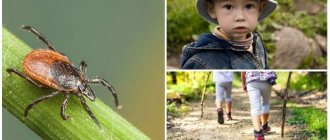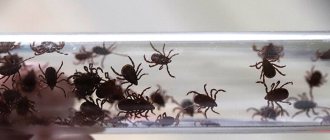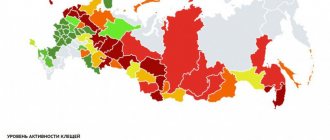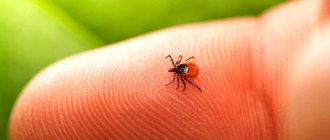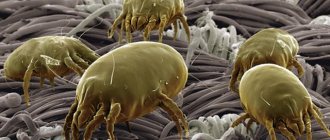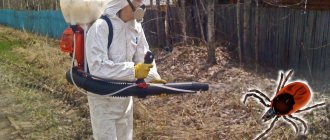You can make forays into nature all your life, go hiking, relax in the summer with your grandmother in the village and still not learn about ticks. Or you can go for a walk in the nearest park and accidentally pick up this dangerous animal.
The tick season begins in early spring (from March) and ends in autumn. Favorable conditions for their existence are air temperature within +20C°, humidity – 80%. Parasites are most active in the spring, when they are just awakening from winter hibernation.
Parasites wake up in early spring during the flowering period of snowdrops and swelling of the buds. As soon as the snow melts and the air warms up, pests crawl out of their shelters. Ticks wake up at a temperature of +1 - +3C°, but become active at +10C°.
The period of tick activity may begin differently in each year. Everything depends on climatic conditions. Ticks appear in the spring after the snow melts and the air warms up, and this can be either the end of March or April. If the winter was harsh, with temperatures dropping to critical levels, the number of parasites will be insignificant.
The most dangerous areas where ticks live
The distribution of ticks can be called worldwide, since they are found in all corners of the globe, even in the Arctic and Antarctic. Encephalitis ticks also live in various regions. But if in some areas an infected tick is very rare, in others the risk of encountering such a parasite is quite high.
The most dangerous areas where ticks live are:
- northern regions of China;
- Korea;
- Mongolia;
- Scandinavia;
- Baltics;
- countries of Central and Eastern Europe.
Habitats
There are many dangerous areas in Russia. These include:
- Perm region;
- Krasnoyarsk region;
- Udmurtia;
- Altai region;
- Buryatia;
- Tyumen region;
- Kurgan region;
- Sverdlovsk region;
- Tomsk region;
- Bashkiria.
Within these areas, foci of infection are distributed unevenly. Their location is determined by the characteristics of the landscape and the boundaries of climatic zones.
Habitats
Ticks prefer moderate humidity and no direct sunlight. Therefore, arachnids are most often found in deciduous and mixed forests, where they live in tall grass or dense undergrowth. However, ticks gradually occupy increasingly larger territories. In recent years, they can increasingly be found in summer cottages and city parks.
Ticks also settle on trees, but almost never rise to a height of more than 1.2 - 1.4 m. Most often, parasites take refuge under the bark or in cracks on the lower part of the trunk. Such shelter attracts arthropods even more if there is dense grass growth around the tree.
How does a tick attack?
Ticks cannot be called active parasites. They do not move long distances in search of prey, preferring to wait for it, sitting in one place. The bloodsucker recognizes the approach of a person or animal by smell, warmth, and movement. Arachnids are practically blind, but they can detect the smell of human sweat or exhaled carbon dioxide at a distance of up to 20 m.
The hunt begins with the tick looking for the most comfortable place for an ambush. Based on temperature, humidity and air composition, the parasite climbs along the stems or grass to a height of 10 cm to 1 m. There it remains, stretching its front legs forward. As soon as a warm-blooded creature passes by, the tick begins to move its legs, trying to catch on with its claws. As soon as contact has occurred, the bloodsucker moves to the future victim.
On a note! There is a misconception that ticks wait for prey, sitting on high branches of trees, and fall on the head or by the collar. This happens extremely rarely, and the parasite can only get to the top by accident.
On clothes
Next, the tick begins to crawl over the prey, trying to move onto a bare body, and once on it, it looks for an area with the thinnest skin and closely spaced blood vessels. After this, it cuts the skin with sharp chitinous plates located on both sides of the proboscis, plunges the proboscis into the wound and begins to suck out the blood.
Weather is a major factor
The parasite attaches itself to the human body through an organ called the hypostome. With its help, it not only holds on to the skin, but also sucks out blood. Irritation occurs in the place where the insect has attached itself. If the parasite is not removed in time, it can lead to dire consequences. The main reason why people suffer from attacks by these creatures is a lack of information. Few people know when ticks appear and disappear.
The first attacks can occur in the early months of spring, when the soil temperature warms up to 0.3 degrees.
Weather conditions greatly contribute to the appearance of ticks. In years when winter is characterized by abnormal heat and spring comes very early, parasites become active extremely quickly and in large numbers. Significant thunderstorms and heavy rains, after which the air temperature rises sharply, also contribute to their appearance. Significant cold is when ticks disappear and cease to pose a danger.
Tick season
It is a known fact that ticks wake up in the spring and disappear in the fall. But it is impossible to give exact dates for the appearance and disappearance of parasites, since they depend on weather conditions and can shift every year. However, tick activity is not always the same, and if you average it out by month, it will look like this:
- March – April – low;
- May – June – high (parasites pose the greatest danger);
- July – August – average;
- September – October – low.
The activity of bloodsucking also varies depending on the time of day. In the morning from 5 to 9 o'clock, and in the evening from 19 to 22 they are most energetic.
When do they appear?
The tick season begins in early spring, when the snow cover melts, the first flowers bloom, and the buds on the trees are just beginning to swell. Parasites that have overwintered in shelters wake up when the air temperature rises to +1… +3⁰С. But at this time, ticks pose virtually no danger, since they are just recovering from a long winter diapause; they become active when the air warms up to +10⁰C.
From the moment ticks appear until the time of their maximum activity, 3 to 5 weeks pass. During this time, the young generation of larvae grows up, which, like adults, can attack animals and people.
In different regions, ticks appear at different times. In the southern regions this can happen as early as March, and in the northern regions in mid- and even late April.
When is the danger especially great?
Throughout the entire period of tick activity, two peaks can be noted when they pose the greatest danger. Ticks are most dangerous in May and June, when both overwintered and young females go hunting to drink blood to reproduce. In addition, it is at this time that most regions usually experience the most comfortable weather for parasites. The temperature reaches +20…+25⁰С, and the forests are quite humid. It is under such conditions that arachnid bloodsuckers reproduce most actively.
The peak of tick activity subsides by the beginning of July. This is due to several factors:
- old females die;
- the air temperature is set above the level comfortable for ticks, the humidity decreases;
- the number of arthropods is declining due to natural enemies - birds and animals - eating them.
By the end of summer, the second generation of young ticks appears. Parasite activity is increasing again, but no longer reaches May and June levels. However, to the question whether a tick bite is dangerous in the fall, the answer will be definitely positive. The likelihood of contracting an infectious disease does not depend on when the parasite attaches itself.
Are ticks dangerous in the fall?
At the beginning of autumn, the parasites remain active. Autumn ticks are no less dangerous than spring or summer ticks. They also bite and can be carriers of infection.
In the bark of a tree
Gradually, there are fewer and fewer ticks in the forest. Tick season ends when cold weather sets in and air temperatures approach freezing. Then the arachnids look for a secluded refuge (under the bark of trees, in the ground, in fallen leaves) and hibernate.
Anyone who wants to know until what time ticks are dangerous, and when you can walk in the forest without fear, must understand that a tick bite, regardless of the time of day or year, carries a risk of infection. It can hardly be said that ticks are dangerous in September, and in October an encounter with them is guaranteed not to pose a threat.
It is impossible to say exactly when ticks disappear. This largely depends on the weather in a particular area, as well as climatic conditions. In the southern regions, you can be attacked by ticks not only in October, but also in November.
National problem
These small parasites are most common in forests in the Siberian, Volga, and Ural districts. There are fewer of them in other regions of the country, but even there people suffer from them. Every year, 400,000 Russians go to medical institutions with bites from these arthropods. It is worth noting that a fourth of this figure are children under 14 years of age. Additionally, these statistics do not include individuals who provided treatment at home. Animals also suffer from these leeches: from dogs to goats.
In order to avoid becoming a victim of parasites, you need to know during what period they become active and when the mites disappear.
Today there are more than 48,000 species in nature. This number is associated with evolution. This class lives in the first layers of soil, the chemical and mineral composition of which varies depending on the territory. The length of ticks is usually from 0.2 to 0.4 mm, but there are also giants that reach 5 mm in size.
Precautions when visiting dangerous areas and places
When outdoors, it is necessary to take measures to help prevent tick bites. This should be done wherever bloodsuckers may be found, but in areas where outbreaks of tick-borne encephalitis or borreliosis have been recorded, precautions are required. Basic recommendations:
- choose the right clothes - they should be light-colored to make it easier to notice a crawling parasite, cover the body as much as possible, have cuffs on the sleeves, fit tightly to the neck, closed shoes;
- put on clothes correctly - trousers tucked into socks or shoes, T-shirt tucked into trousers, a hood or hat on the head;
- Before a walk, treat clothes and exposed areas of the body with a special agent that repels parasites;
- You should avoid tall grass or dense bushes; it is best to move along the middle of the path;
- You cannot sit or lie down on the ground or grass; be sure to lay a blanket, film, or rug underneath;
- periodically you need to inspect your clothes for ticks;
- for rest and overnight stays, it is best to choose dry meadows with short grass, preferably among coniferous trees;
- upon returning from the forest, the clothes must be carefully examined, shaken out, and best of all, washed at high temperature; the body and hair are also carefully examined (if there were pets on the walk, they also need to be examined, since the ticks they brought can later move on to people).
These rules must be adhered to throughout the entire period of tick activity. We must remember that even in the fall, when the parasites disappear, finding shelter for the winter, individual individuals can still be awake and attack.
Feasibility of vaccination
In Siberia, the issue of protection from dangerous pests is acute. Resist mass disease with a vaccine. People who plan to visit Siberia in the next six months are subject to mandatory vaccination. In this way you can protect yourself from encephalitis. 3 vaccinations are provided with an interval of 1 month. Vaccinations are carried out in Moscow and other cities in public and private clinics.
There is no vaccine against borreliosis and some other diseases; they protect themselves with repellents to repel parasites and thick clothing. In the forest you should dress so that there are no exposed skin areas. When you get home, you should throw everything in the wash.
On a note!
Once a tick appears on a human body, it does not immediately become active. Absorbed into the skin after approximately 2-3 hours. In a simple way you can protect yourself from a dangerous disease.
